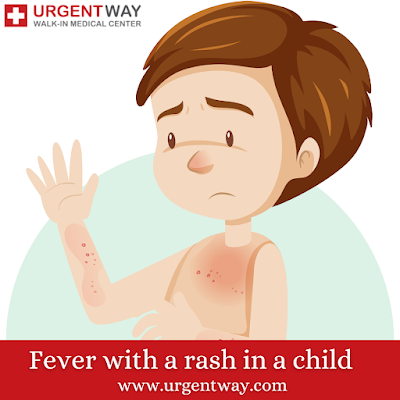Fever with a rash in a child: Types and when to see a doctor
Viral Rashes:
- Examples: Roseola, Fifth disease (Erythema infectious), Measles, Chickenpox (Varicella), etc.
- Characteristics: Rashes caused by viral infections may present with different patterns and appearances. They may be accompanied by a high fever, runny nose, cough, and other flu-like symptoms.
- When to see a doctor: Most viral rashes are self-limiting and resolve on their own. However, you should seek medical advice if the fever is persistent, the child appears very ill, or if the rash becomes widespread or painful.
Bacterial Rashes:
- Examples: Scarlet fever, certain staph or strep infections, etc.
- Characteristics: Bacterial rashes may vary in appearance, and some can be more serious than others. Scarlet fever, for instance, presents with a sandpaper-like rash and may be accompanied by a fever and sore throat.
- When to see a doctor: Prompt medical attention is essential for bacterial rashes. If your child has a rash with a fever, especially if they are also experiencing difficulty swallowing, breathing problems, or dehydration, seek medical help immediately.
Allergic Rashes:
- Examples: Allergic reactions, such as hives (urticaria).
- Characteristics: Allergic rashes typically appear suddenly and may be accompanied by itching, redness, and swelling.
- When to see a doctor: If you suspect an allergic reaction is causing the rash and fever, especially if there is any difficulty breathing, swelling of the face or throat, or signs of anaphylaxis, seek emergency medical attention right away.
Kawasaki Disease:
- Characteristics: Kawasaki disease is a rare but serious condition that can cause fever, rash, red eyes, swollen lymph nodes, and inflammation of the blood vessels.
- When to see a doctor: If your child has an unexplained fever that lasts for several days, along with other symptoms like a persistent rash, red eyes, swollen hands or feet, or changes in behavior, contact a doctor immediately. Kawasaki disease requires early treatment to prevent complications.
Treatments
Most feverish rashes are caused by viral infections.
Antibiotics and other medicines cannot treat the virus. Instead, doctors focus
on controlling symptoms. They may recommend:
- Rest as much as possible
- Drink plenty of fluids
- Taking medicine to reduce fever
Depending on the cause of the symptoms, in severe cases, the
child may sometimes need to stay in the hospital.
Antibiotics can treat cellulitis and similar skin
infections, as well as strep infections. Occasionally, a viral rash becomes
infected, especially if a child scratches it a lot. If this happens, the child
may need antibiotics. Antibiotics will get rid of the infection, but they won't
treat the rash.
At UrgentWay's Pediatric Urgent Care Center, we provide
treatment for a wide variety of common ailments.




Comments
Post a Comment